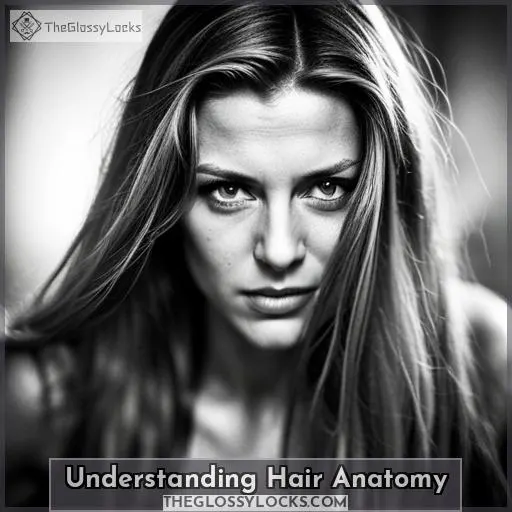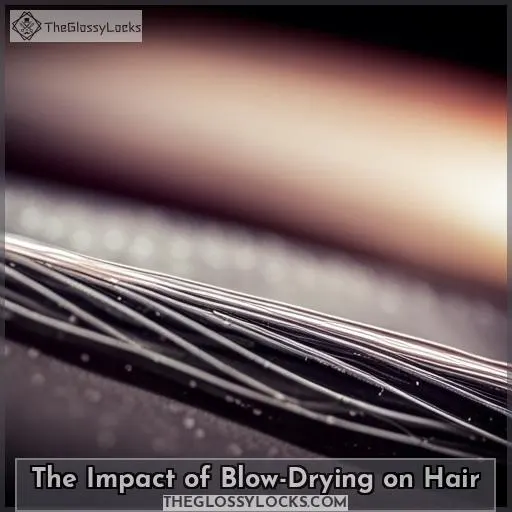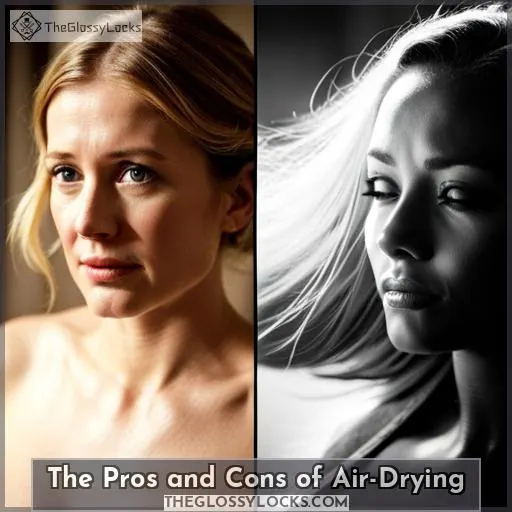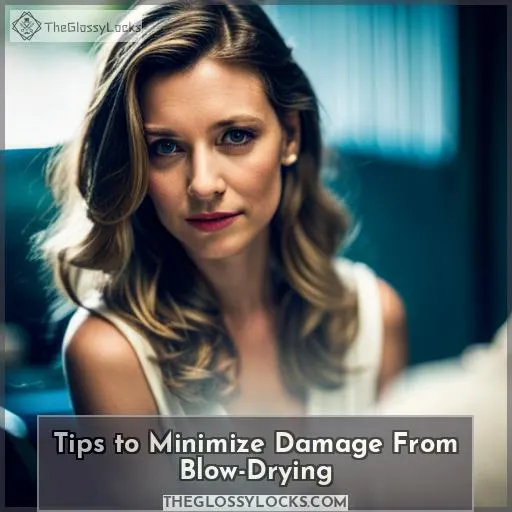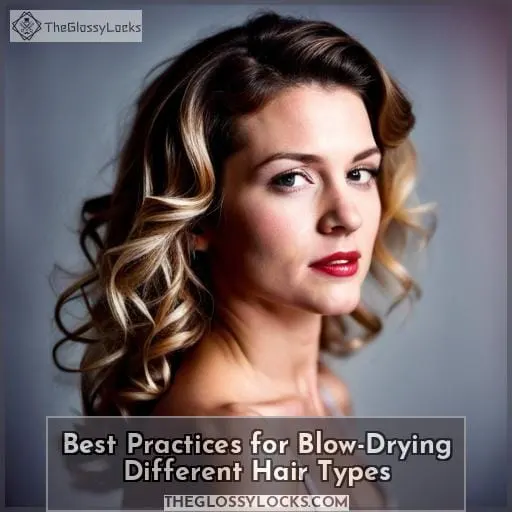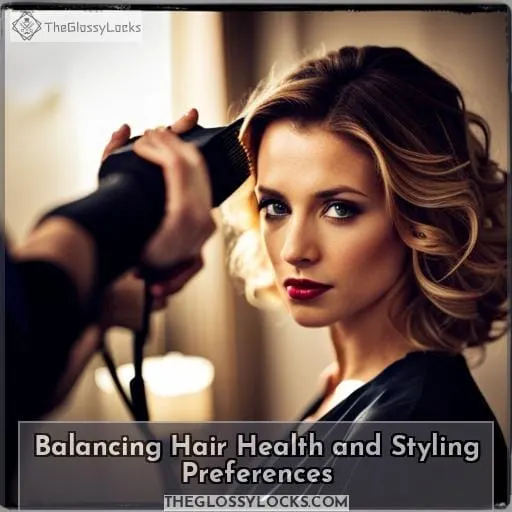This site is supported by our readers. We may earn a commission, at no cost to you, if you purchase through links.
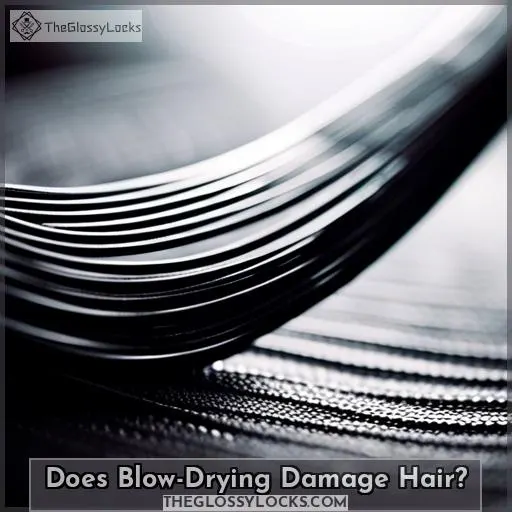 Imagine having the power to style your hair just the way you want it, without worrying about damage. Well, when it comes to blow-drying your hair, there’s a lot of debate about whether or not it harms your precious locks.
Imagine having the power to style your hair just the way you want it, without worrying about damage. Well, when it comes to blow-drying your hair, there’s a lot of debate about whether or not it harms your precious locks.
In this article, we’ll explore the impact of blow-drying on different hair types and provide tips to minimize any potential damage.
Table Of Contents
- Key Takeaways
- Understanding Hair Anatomy
- The Impact of Blow-Drying on Hair
- The Pros and Cons of Air-Drying
- Tips to Minimize Damage From Blow-Drying
- Best Practices for Blow-Drying Different Hair Types
- Achieving a Professional Blowout at Home
- Balancing Hair Health and Styling Preferences
- Frequently Asked Questions (FAQs)
- How does blow-drying impact the health of the hair cuticles?
- What are the potential risks of air-drying compared to blow-drying?
- What type of heat protectant is recommended for blow-drying?
- How does the heat setting on a blow dryer affect hair damage?
- What are some tips for achieving a professional blowout at home while minimizing damage to the hair?
- Conclusion
Key Takeaways
- Blow-drying can damage the hair cuticles and weaken the fibers, leading to dryness and disrupted moisture balance.
- Using a heat protectant, maintaining distance, and controlling heat settings can minimize blow-drying damage.
- Air-drying is a healthier option that reduces heat damage, but it requires longer drying time and more effort.
- Different hair types require specific care when blow-drying, such as using thermal protection for straight hair and a diffuser on low heat for curly hair.
Understanding Hair Anatomy
To understand the potential impact of blow-drying on your hair, it’s important to have a basic understanding of its anatomy.
Hair consists of three main layers: the cuticle, cortex, and medulla.
The cuticle serves as the outer layer and acts as a protective barrier against heat exposure.
The cortex makes up the middle layer and contains keratin proteins and structural lipids that give strength to the hair strands.
Lastly, some individuals have an innermost layer called the medulla, which consists of loosely packed cells.
In addition to these layers, another essential component related to hair health is known as the cell membrane complex (CMC). This complex acts like glue holding together different parts of each strand’s structure including various combinations such as cuticle-cuticle interactions or connections between both cortex-cortex or even cuticle-cortex interfaces.
Understanding these aspects can help you comprehend how heat styling affects your hair at a cellular level so that you can implement appropriate heat defense strategies during blow drying sessions while ensuring optimal moisture levels within your precious locks’ cortical regions remain intact for maximum protection against any potential harm caused by excessive temperatures applied during this process!
The Impact of Blow-Drying on Hair
Blow-drying your hair can have a significant impact on its overall health.
The high temperatures from the dryer can cause damage to the hair cuticles, which serve as a protective barrier for your strands. This damage can lead to frizz, tangles, and breakage if not properly addressed and mitigated.
Damage to Hair Cuticles
Blow-drying can have a significant impact on the health of your hair cuticles.
Your hair cuticles, which serve as the outer layer of protection for your strands, are vulnerable to heat damage during blow-drying.
High temperatures above 284 degrees Fahrenheit can cause irreversible damage to your cuticles, leading to frizz and breakage.
To prevent this damage, it’s important to prioritize cuticle care by using a heat protectant before blow-drying and styling safely with lower heat settings.
By taking these precautions, you can minimize the risk of hair damage and enjoy the benefits of a beautiful blowout without compromising hair health.
Effects on Hair Fibers
Blow-drying frequently affects the health of hair fibers by subjecting them to high temperatures and intense airflow.
- Cuticle Protection: The outer layer of the hair, known as the cuticle, plays a crucial role in protecting against heat damage. Blow-drying can cause damage to this protective layer if not done properly.
- Fiber Integrity: Excessive heat from blow-drying can weaken and degrade the structural integrity of individual hair fibers over time.
- Moisture Balance: Blow-drying removes moisture from the strands, disrupting their natural moisture balance and potentially leading to dryness or brittleness.
To minimize these negative effects on your precious locks while blow drying your hair:
- Use a heat protectant spray before blow drying
- Keep an optimal distance between your dryer nozzle and your tresses
- Avoid excessive use or overheating with styling tools
The Pros and Cons of Air-Drying
When it comes to air-drying your hair, there are both pros and cons to consider.
On the positive side, air-drying can help reduce heat damage and preserve the natural texture of your hair.
However, on the downside, it can take longer for your hair to dry completely and may require more effort in terms of detangling and styling.
Understanding these factors will help you make an informed decision about whether or not air-drying is right for you.
Potential Damage to Hair Fibers
While blow-drying can potentially cause damage to hair fibers, it’s important to also consider the pros and cons of air-drying.
Air-drying may seem like a safer option, but it can actually be damaging to the hair shaft and follicles. When wet hair is exposed to continuous water during air drying, it can weaken the strands and lead to frizz, tangles, and breakage.
It’s crucial to find a balance between styling safely with heat protectants while maintaining moisture balance for healthier fiber health.
| Potential Damage from Air-Drying | Benefits of Air-Drying | Styling Safely with Blow Drying Innovations |
|---|---|---|
| Weakens strands leading | Reduces exposure | Use heat protectant products before |
Frizz Dryness blow drying
Tangles Preservation of curls Gradually reduce heat & speed
Breakage No thermal impact
Simple & convenient Choose gentle tools
Appropriate temperature setting
Benefits of Air-Drying
Air-drying offers a multitude of benefits for your hair.
- Less frizz: Air-drying helps reduce frizz and flyaways, leaving you with smoother strands.
- No heat damage: By skipping the blow dryer, you avoid exposing your hair to excessive heat that can lead to damage and breakage.
- Preserves curls: Air-drying allows your natural curls or waves to take shape without altering their pattern.
Additionally, air-drying is quick and easy, requires no styling products, and helps retain moisture in the hair for improved health.
Tips to Minimize Damage From Blow-Drying
To minimize damage from blow-drying, there are several tips you can follow:
- First, make sure to apply a heat protectant spray or damage defense primer before using the hair dryer.
- Additionally, towel-dry your hair gently with a soft and lightweight towel to prevent roughening the cuticles.
- Lastly, be mindful of the heat setting on your dryer and opt for lower temperatures to reduce potential damage to your strands.
Using Heat Protectant
To minimize damage from blow-drying, you can protect your hair by using a heat protectant spray or cream.
These products create a protective barrier between your strands and the heat exposure, reducing the potential damage caused by high temperatures.
When applying heat protectant, make sure to evenly distribute it throughout your hair for maximum coverage.
Layering products such as blow dry primers can also provide additional protection and improve overall hair health while setting the right heat temperature is essential to prevent excessive damage.
Towel-Drying Techniques
To minimize damage from blow-drying, you can employ effective towel-drying techniques that help prepare your hair for the heat.
- Use absorbent materials like bamboo or microfiber towels to gently remove moisture without roughening cuticles.
- Avoid rubbing your hair vigorously with a towel to prevent breakage and tangling.
- Consider using hair-friendly towels that promote moisture retention for healthier-looking locks.
Controlling Heat Settings
To minimize damage from blow-drying, you can control the heat settings on your hair dryer.
Heat management is crucial in preventing excessive heat exposure and minimizing potential damage to your hair.
Adjusting the temperature control allows you to find a suitable level of heat that won’t cause harm to your strands.
By using lower heat settings and avoiding high temperatures, you can effectively prevent heat damage during the blow-drying process while still achieving desired results for different hair conditions.
Best Practices for Blow-Drying Different Hair Types
When it comes to blow-drying different hair types, there are certain best practices that you should follow.
For straight hair,
- Towel and air dry until partially dry
- Apply heat protectant
- Use a round brush for shine
Curly hair requires
- Detangling with a wide-tooth comb
- Applying leave-in conditioner and defining curl gel
- Using a diffuser on low or medium heat
With long hair, it’s important to use
- Specific shampoo and conditioner
- Nourishing oils or leave-in conditioners
- Towel drying before blow drying to minimize damage.
Straight Hair
For straight hair, you can achieve the best blow-drying results by following these simple and effective tips:
- Use thermal protection to shield your hair from heat damage.
- Apply styling products that provide volume and control frizz.
- Utilize techniques like round brushing to add lift and create a smooth finish.
- Consider using a diffuser attachment for added texture while blow-drying.
Curly Hair
For curly hair, it’s important to follow specific best practices when blow-drying to minimize damage and achieve desired results.
To preserve your curls, start by managing moisture with a leave-in conditioner.
Use an ionic dryer on low heat to reduce frizz and prevent excessive drying.
Employ styling techniques like diffusing or using a wide-toothed comb for gentle detangling.
With these tips, you can embrace the power of heat-free styling while maintaining healthy, beautiful curls.
Long Hair
If you have long hair, there are specific best practices to follow when blow-drying in order to minimize damage and achieve a beautiful result.
To care for your long locks, start by:
- Conditioning your hair regularly
- Using the right tools
- Avoiding excessive heat
- Using low-speed settings on your dryer
- Considering incorporating braiding techniques or updo styles for added protection
- Trimming split ends regularly for optimal hair wellness
Achieving a Professional Blowout at Home
To achieve a professional blowout at home, it’s important to master proper technique and use the right tools.
- Sectioning your hair and styling in small sections will ensure thorough drying and a polished look.
- Finish with cool air to set the style.
- Consider using water-based pomade for versatile styling.
Proper Technique and Tools
To achieve a professional blowout at home, follow these steps.
Start by using heat protection spray to safeguard your hair from damage.
Choose the right styling accessories, such as soft plastic brushes for gentle detangling and volumizing.
Control the drying process by holding the dryer about 6 inches away from your hair and gradually reducing heat and speed as it dries.
By mastering proper technique and utilizing the right tools, you can minimize potential harm to your hair while achieving salon-worthy results in the comfort of your own home.
Sectioning and Styling Tips
To achieve a professional blowout at home, start by sectioning your hair for easier and more manageable styling.
- Use sectioning clips to divide your hair into smaller sections.
- Before blow-drying, apply heat protection to shield your strands from damage.
- Choose a brush suitable for your hair type – soft bristles work well for fine or damaged hair while boar bristle brushes are great for thick or curly hair.
- Maintain an optimal distance of about six inches between the dryer and your locks to prevent excessive heat exposure.
- Make gradual adjustments in both speed and temperature as you dry each section, starting with low-medium heat settings until desired results are achieved.
- Remember that excess water can prolong drying time, so gently towel-dry before using the dryer.
Finishing Touches for a Polished Look
Once you’ve completed sectioning and styling, finish with a spritz of holding spray or pomade for a polished look achieving that salon-quality blowout at home.
- Use a high-quality holding spray to maintain the style throughout the day.
- Apply pomade to add shine and control flyaways for sleek hair.
Enhance your blowout with professional flair by using finishing touches.
- Achieve haircare elegance by incorporating these blowout secrets into your routine.
- Master the art of styling finesse to create shiny, beautiful locks.
Balancing Hair Health and Styling Preferences
Find the perfect balance between maintaining healthy hair and achieving your desired style when blow-drying.
While blow-drying can cause damage to your hair if not done correctly, there are ways to protect and care for your locks while still achieving the look you desire.
One option is using heat protection sprays or damage defense primers before using a hair dryer. These products create a barrier between the heat and your strands, reducing potential damage.
Another alternative is incorporating natural remedies into your haircare routine, such as nourishing oils like argan or coconut oil that can provide hydration and protect against heat styling.
In addition to protecting your hair during blow-drying, it’s important to prioritize scalp health as well. Massaging natural oils into the roots of your hair can help nourish both the scalp and strands while promoting overall hair health.
Customizing Your Haircare Routine:
To find what works best for you in terms of balancing styling preferences with maintaining healthy tresses,
consider customizing
your
haircare routine.
This allows you to tailor products specifically based on
your needs,
whether it be dryness,
damage from heating tools,
or sensitivity.
By giving attention
to both protection
and overall care,
you’ll be able
to enjoy styled
hair without compromising its healthiness
Frequently Asked Questions (FAQs)
How does blow-drying impact the health of the hair cuticles?
Blow-drying, when done improperly, can damage the health of hair cuticles.
The heat from blow dryers weakens and causes irreversible damage to the cuticle layer, leading to frizz, tangles, and breakage.
What are the potential risks of air-drying compared to blow-drying?
Air-drying may seem gentle, but research suggests it can damage the hair’s Cell Membrane Complex (CMC) more than blow-drying.
Wet hair exposed to water for prolonged periods weakens strands.
Consider minimizing air-drying and using proper techniques when blow-drying.
What type of heat protectant is recommended for blow-drying?
For blow-drying, use a silicone-based heat protectant to distribute heat evenly and prevent bubbling inside the hair fibers.
Function of Beauty’s custom hair serum offers thermal protection up to 400 degrees Fahrenheit.
How does the heat setting on a blow dryer affect hair damage?
The heat setting on a blow dryer directly impacts hair damage.
Higher heat settings cause greater harm to the cuticles and overall health of your hair.
Opt for a relatively low temperature, around 140 degrees Fahrenheit, to minimize damage while blow drying.
What are some tips for achieving a professional blowout at home while minimizing damage to the hair?
Achieve a professional blowout at home without damaging your hair.
Use high-quality tools, like the Signature Series Textur® Professional Texturizing Iron, and follow proper techniques for your hair type.
Power up your style while keeping it healthy!
Conclusion
In the quest for the perfect hairstyle, many have wondered if blow-drying is damaging their precious locks. After exploring the impact of blow-drying on different hair types, it’s clear that blow-drying can indeed cause damage to hair cuticles and fibers.
However, with the right techniques and precautions, the potential damage can be minimized.
Using heat protectant, employing proper towel-drying techniques, and controlling heat settings are just a few ways to protect your hair while blow-drying.
So go ahead and enjoy the freedom of styling your hair the way you want, while keeping your locks healthy and beautiful.

